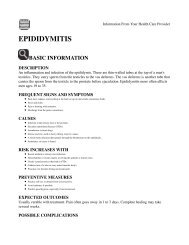Strep Throat.pdf - Family Practice Center of Wadsworth
Strep Throat.pdf - Family Practice Center of Wadsworth
Strep Throat.pdf - Family Practice Center of Wadsworth
You also want an ePaper? Increase the reach of your titles
YUMPU automatically turns print PDFs into web optimized ePapers that Google loves.
Information From Your Health Care Provider<br />
STREP THROAT<br />
(<strong>Strep</strong>tococcal Sore <strong>Throat</strong>)<br />
BASIC INFORMATION<br />
DESCRIPTION<br />
Infection <strong>of</strong> the throat (the pharynx) by group A streptococcus (GAS) bacteria. <strong>Strep</strong> throat can spread<br />
from person to person and is most common in children. Infection can be present in someone with no<br />
symptoms, but who can still spread the germs (carrier state).<br />
FREQUENT SIGNS AND SYMPTOMS<br />
Rapid onset <strong>of</strong> throat pain.<br />
<strong>Throat</strong> pain that is worse when you swallow.<br />
Headache, fever, general ill feeling.<br />
Children may have nausea and vomiting.<br />
Tender, swollen glands in the neck.<br />
Bright-red tonsils that may have specks <strong>of</strong> pus.<br />
CAUSES<br />
<strong>Strep</strong>tococcal bacteria. Germs are spread by contact with an infected person, breathing in germs in the<br />
air, or touching an object with germs on it. A person usually has symptoms in 2 to 5 days <strong>of</strong> exposure.<br />
<strong>Strep</strong> throat is one <strong>of</strong> the most common types <strong>of</strong> infection caused by group A streptococcus. It can<br />
also cause skin infections and other health problems.<br />
RISK INCREASES WITH<br />
Recent strep infection in a family member.<br />
Crowded living conditions such as a dorm.<br />
Being in day-care center or attending school.<br />
PREVENTIVE MEASURES<br />
Avoid close contact with anyone with strep throat.<br />
Avoid germs. Wash hands <strong>of</strong>ten, especially children.<br />
EXPECTED OUTCOMES<br />
Curable with treatment. Symptoms are usually better in the first few days <strong>of</strong> treatment. Any<br />
complications are rare.<br />
POSSIBLE COMPLICATIONS<br />
Ear infection.
Sinusitis.<br />
Rheumatic fever or scarlet fever.<br />
Glomerulonephritis (a kidney disorder).<br />
DIAGNOSIS & TREATMENT<br />
GENERAL MEASURES<br />
Your health care provider will examine the throat. A sore throat (pharyngitis) can also be caused by virus infection, allergies, or other problems. Further<br />
tests are usually needed. A throat culture or rapid strep test can confirm a strep infection.<br />
Treatment for strep infection is with antibiotic drugs.<br />
To help relieve the pain, gargle <strong>of</strong>ten with double-strength tea or warm salt water (1 teaspoon <strong>of</strong> salt to 8 oz. <strong>of</strong> water).<br />
MEDICATIONS<br />
Penicillin or another antibiotic will be prescribed. Finish the complete 10-day dose, even if symptoms get better. This helps prevent any complications or<br />
recurrence <strong>of</strong> the infection.<br />
Use over-the-counter pain medicine, such as ibupr<strong>of</strong>en, if needed. Don't give aspirin to children.<br />
<strong>Throat</strong> lozenges for sore throats are available from drugstores and may help with pain relief.<br />
ACTIVITY<br />
Return to normal activities as symptoms improve. A person can no longer spread the germs if they<br />
have taken the antibiotic drug for at least 24 hours.<br />
DIET<br />
A liquid diet may be helpful while the throat is sore. Drink plenty <strong>of</strong> fluids, including milk shakes,<br />
soups, tea, carbonated drinks, and iced c<strong>of</strong>fee. Any type and amount <strong>of</strong> solid food is fine as long as<br />
you can swallow it without too much pain.<br />
NOTIFY OUR OFFICE IF<br />
You or a family member has symptoms <strong>of</strong> strep throat.<br />
The following occur during treatment:<br />
Fever recurs after being normal for a few days.<br />
New symptoms appear, such as nausea, vomiting, earache, cough, swollen glands, skin rash, severe<br />
headache, nasal drainage, or shortness <strong>of</strong> breath.<br />
Joints become red or painful.















